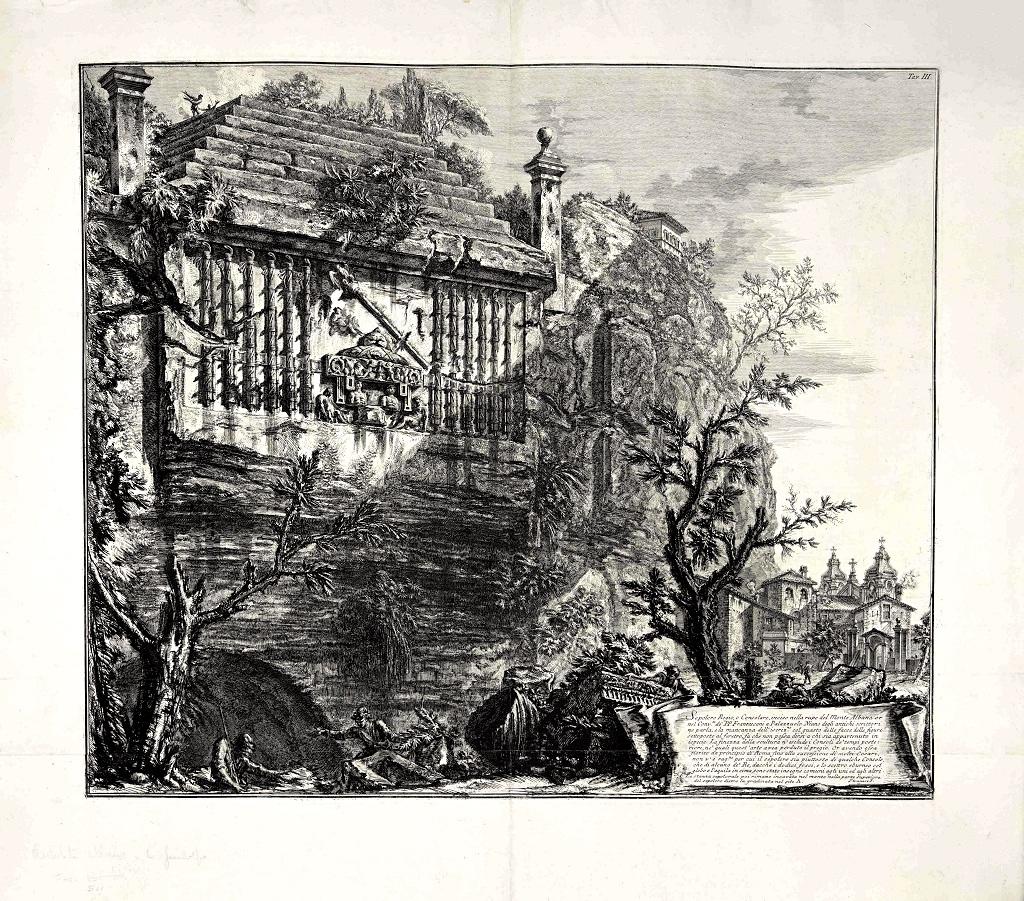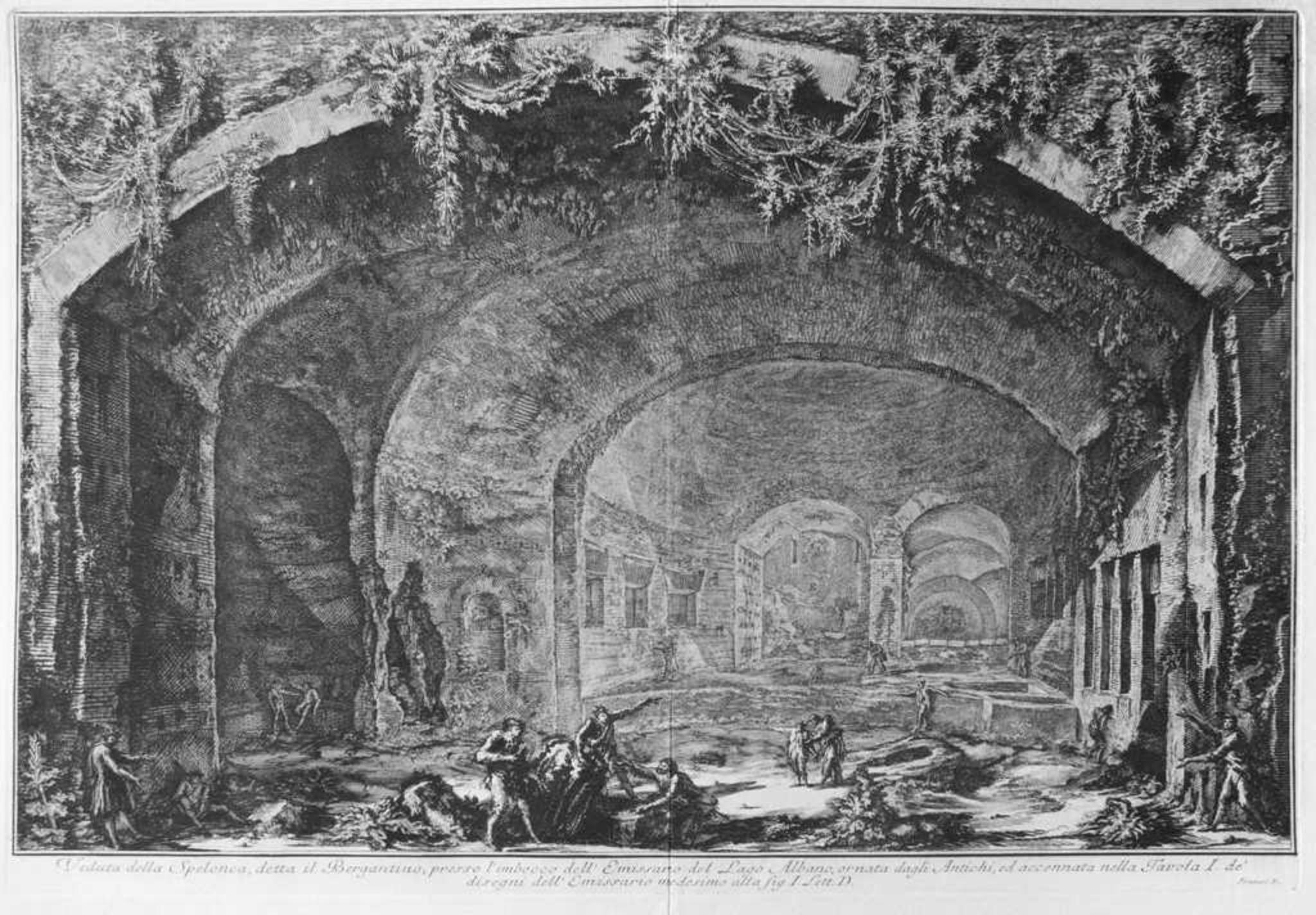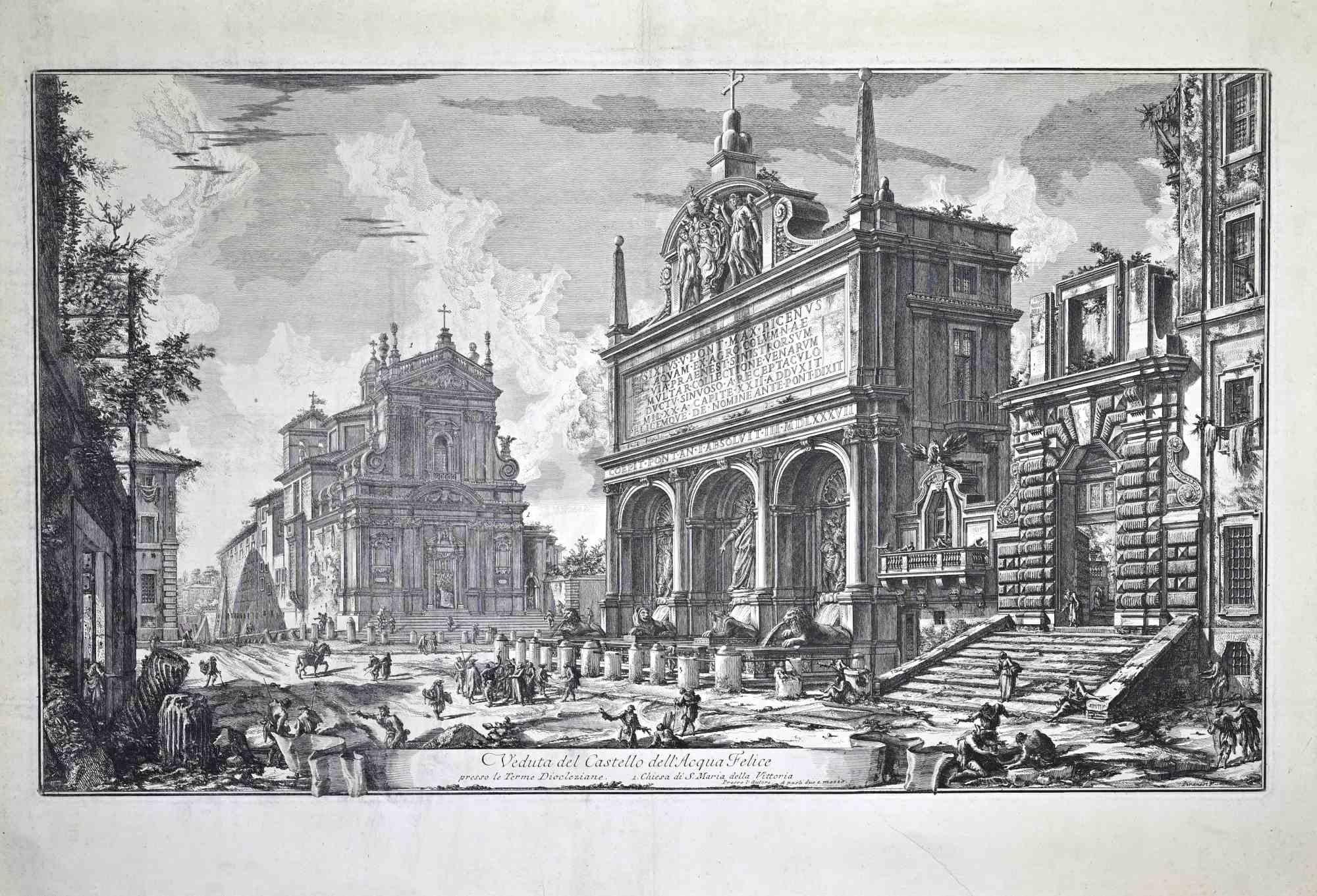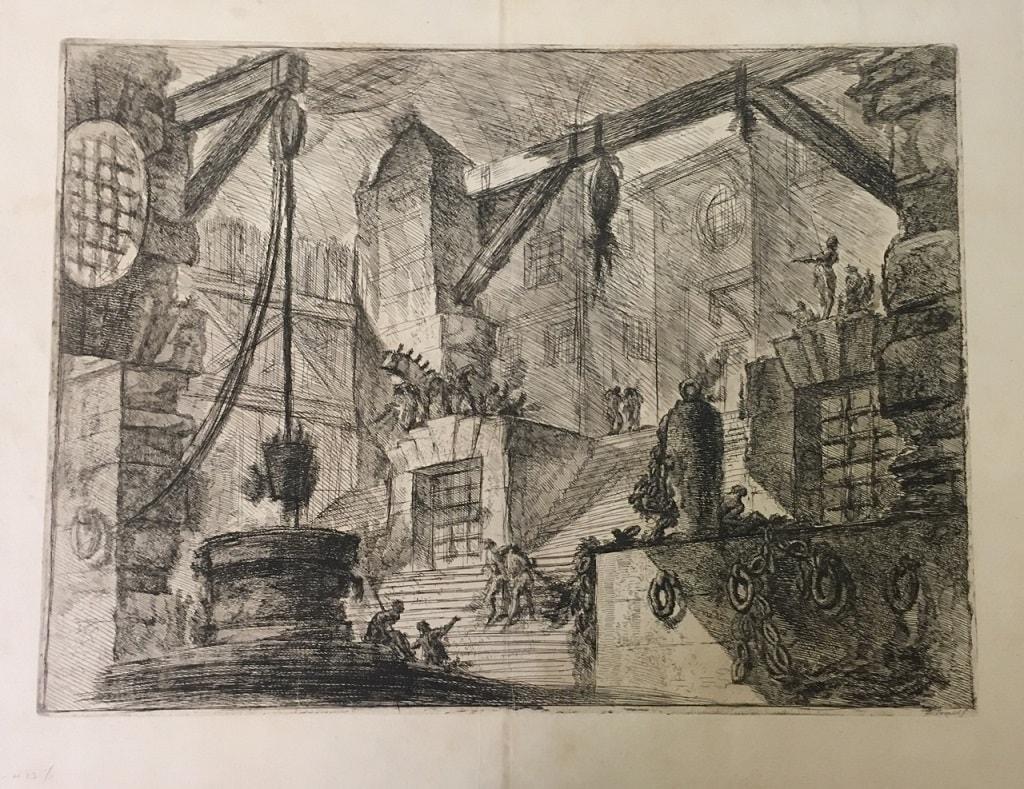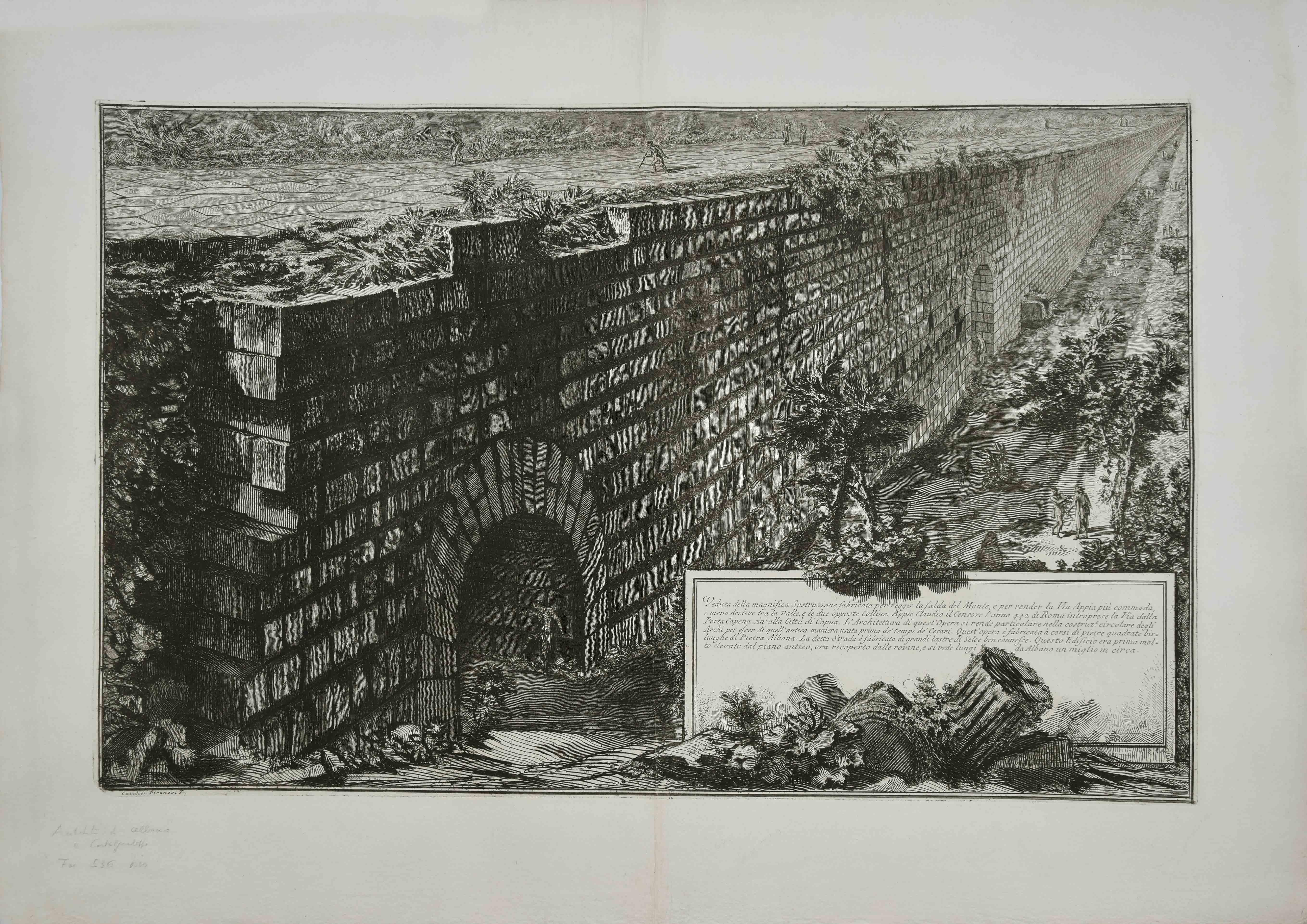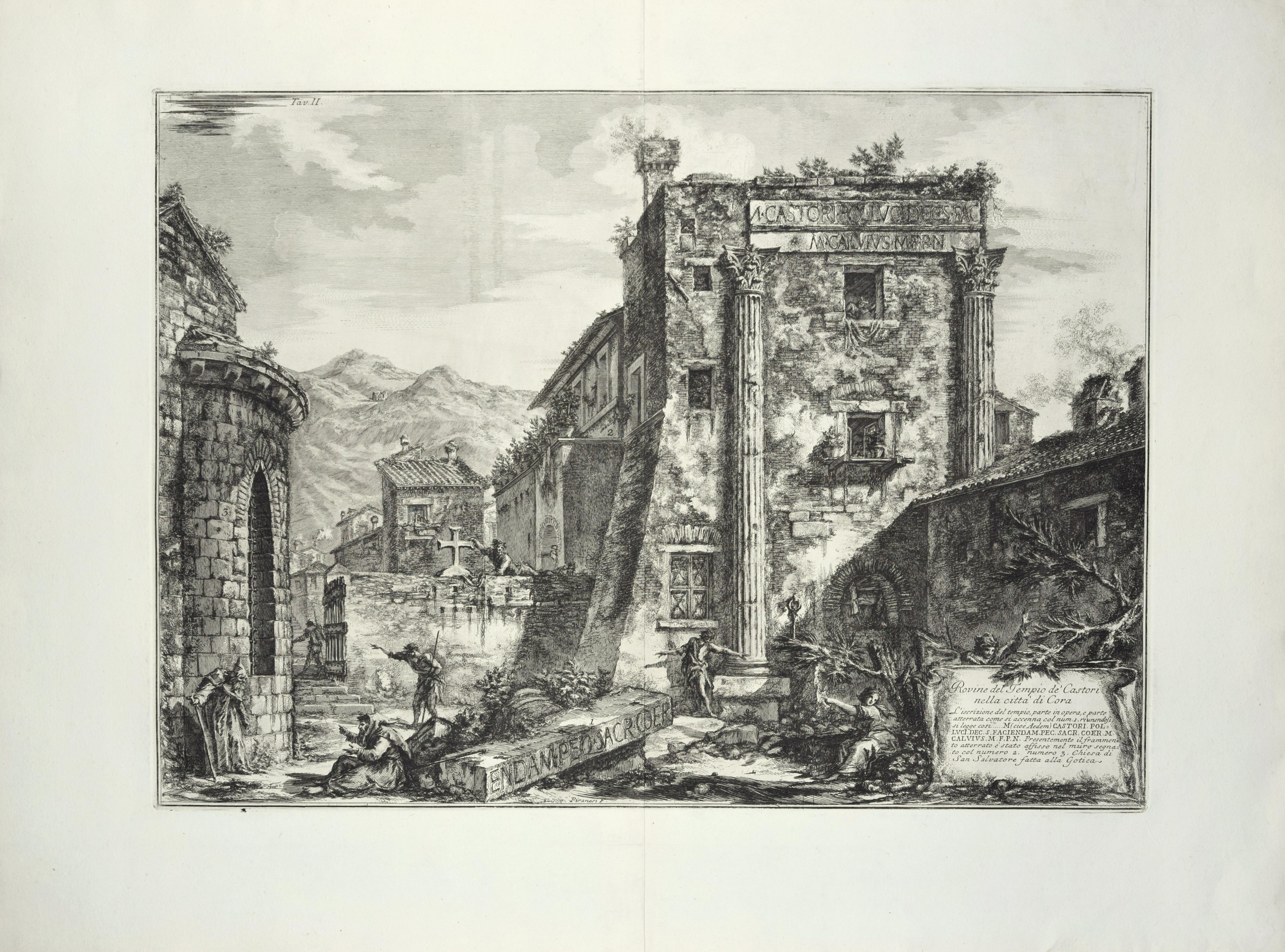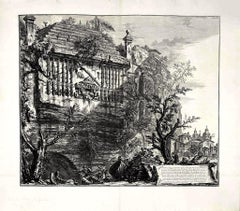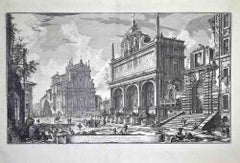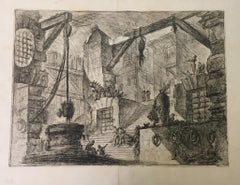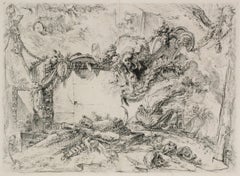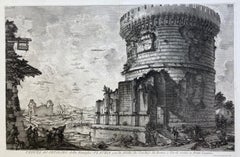Items Similar to Frontispiece from "Carceri d'Invenzione" - Etching by G. B. Piranesi - 1749/59
Want more images or videos?
Request additional images or videos from the seller
1 of 6
Giovan Battista PiranesiFrontispiece from "Carceri d'Invenzione" - Etching by G. B. Piranesi - 1749/591749/50
1749/50
$28,497.62
£21,537.42
€24,000
CA$39,808.76
A$43,307.81
CHF 22,852.87
MX$520,851.12
NOK 288,280.08
SEK 268,290.31
DKK 182,825.59
About the Item
Carcere d'Invenzione is an original Modern Artwork realized by Giovan Battista Piranesi (Mogliano Veneto, 1720 - Rome, 1778).
Original Etching with Burin details on Laid paper. I state.
Inscripted in the center, in imitation of a carved epigraph: "INVENTIONS / CAPRIC OF PRISONS / ALL ACQVA FORTE / DATED IN LVCE / BY YOUNG PEOPLE / BOUCHARD IN / ROME MERCANTE / AL CORSO".
Print dimensions: mm 545 x 410; sheet dimensions: mm 635 x 494.
This beautiful specimen belongs to the first edition 1749/50.
In excellent conditions.
Reference:
Hind, Arthur Mayer, Giovanni Battista Piranesi : a critical study with a list of his published works and detailed catalogues of the prisons and the views of Rome, London, Cotswold Gallery, 1922, 1. (ed. consultata London, Holland Press, 1967), p. 24, n. 1;
Focillon Henri, Giovanni Battista Piranesi, ediz. italiana a cura di Maurizio Calvesi e Augusta Monferini, Bologna, Alfa, 1967, p. 285, n. 24;
Robison Andrew, Piranesi. Early architectural fantasies. A Catalogue Raisonné of the Etchings, Washington, National Gallery of Art, 1986, n. 29/II;
Wilton-Ely John, Giovanni Battista Piranesi. The complete etchings, San Francisco, AlanWofsy, 1994, n. 26;
Ficacci Luigi, Piranesi. The complete etchings, Koln, Taschen, 2000 (ed. 2001), pp. 128-153.
The scene is an example of the entire cycle, one of the most cryptic and technically complex due to the creative genius of the Venetian engraver. The title is placed on a huge gravestone, placed close to a wall; walkways leading in different directions and a wide staircase are described on the right while a chained figure, characterized by a dramatically tense expression, is outlined above the title and dominates the entire composition. The representation closes on the left with a part of the wall arch that seems to open the viewer's gaze on a world of anguish and fear.
Many states have been identified - nine those reported by Robison - even after the artist's death, when the branches were purchased by the publisher Firmin-Didot, which in 1835-1839 succeeded with a fifth edition. Focillon carefully details the question of the dating of the first edition and the different theses expressed by scholars starting as early as the end of the 18th century; many agree in distinguishing the engraving of the plates, to be traced back to about 1745, from their publication, which took place around 1750, while the final enlarged edition of two tables would be placed between 1760 and 1761. Several drawings can be traced back to the plates of the series. .
Giovanni Battista Piranesi, also known as Giambattista (Venice, 1720 - Rome, 1778), was an Italian engraver, architect and theorist of architecture. His engraved tables, marked by dramatic intonation and graphics, appear to be marked by an idea of Roman dignity and magnificence, expressed through the grandeur and isolation of the architectural elements, in order to arrive at a sublime feeling of grandeur of the ancient past, although marked by inexorable abandonment. The eclecticism of his works and the versatility of his creative inspiration make Piranesi an artist difficult to insert within a schematic dictated by a subdivision into styles or artistic currents. A personality with a double cultural matrix, Venetian and Roman, Piranesi has a very complex artistic physiognomy, which can be divided into three fundamental components. In fact, Piranesi's art has deep roots in the Rococo tradition, of which he is one of the last heirs. This adherence to Rococo can be found not only in the quality of the design, unmade and evocative, but above all in the very nature of his works, which are configured as capricious inventions (as we read in the title page of the Carceri): with this exquisitely Rococo name, in fact , Piranesi wanted to indicate the imaginative and unusual character of his creations.
- Creator:Giovan Battista Piranesi (1720 - 1778)
- Creation Year:1749/50
- Dimensions:Height: 25.2 in (64 cm)Width: 19.69 in (50 cm)Depth: 0.04 in (1 mm)
- Medium:
- Movement & Style:
- Period:
- Framing:Framing Options Available
- Condition:Insurance may be requested by customers as additional service, contact us for more information.
- Gallery Location:Roma, IT
- Reference Number:Seller: M-1109881stDibs: LU65037283002
About the Seller
4.9
Platinum Seller
Premium sellers with a 4.7+ rating and 24-hour response times
1stDibs seller since 2017
7,837 sales on 1stDibs
Typical response time: 1 hour
- ShippingRetrieving quote...Shipping from: Roma, Italy
- Return Policy
More From This Seller
View AllSepolcro Regio, o Consolare , inciso nella rupe... - G. B. Piranesi - 1764
By Giovanni Battista Piranesi
Located in Roma, IT
Sepolcro Regio, o Consolare , inciso nella rupe del Monte Albano (Royal or Consular Tomb in the Alban Hills) is an original etching realized by Giovan Battista Piranesi in 1764.
Ed...
Category
1760s Figurative Prints
Materials
Etching
Veduta della Spelonca, detta il Bergantino - Etching by G. B. Piranesi - 1762
By Giovanni Battista Piranesi
Located in Roma, IT
Veduta della Spelonca, detta il Bergantino is an original etching realized by G. B. Piranesi in 1762.
Image Dimensions: 43 x 63 cm
Very good condition.
Ref. Ficacci., p.442
Category
1760s Landscape Prints
Materials
Etching
Veduta del Castello dell'Acqua Felice... Etching by Giovan B. Piranesi - 1875
By Giovanni Battista Piranesi
Located in Roma, IT
Etching realized by Giovan Battista Piranesi in 1875.
Image dimension: 40.5x52 cm.
Sheet dimension 68.5x74.3 cm.
Signed on the plate lower right. Plate from Views of Rome. Excell...
Category
1870s Modern Figurative Drawings and Watercolors
Materials
Etching
The Well, Carcere XIII - Etching by G.B.Piranesi - 1750s
By Giovanni Battista Piranesi
Located in Roma, IT
Giovanni Battista Piranesi, The Well, Carcere XIII , from “ Images of Prisons”, Buchard , Rome, 1749-50
Etching on laid paper. Signed on plate “ Piranesi F.” lower-right. Very good ...
Category
1750s Modern Interior Prints
Materials
Etching
Veduta della Magnifica Sostruzione Fabricata - Etching by G. B. Piranesi -1760s
By Giovanni Battista Piranesi
Located in Roma, IT
View of the magnificent substructure is an original etching realized by the italian artist Giovanni Battista Piranesi.
Very precoius and rare specimen. Roman edition.
Complete tit...
Category
Late 18th Century Figurative Prints
Materials
Etching
Rovine del Tempio de' Castori nella città di Cora - Etching by G. B. Piranesi
By Giovanni Battista Piranesi
Located in Roma, IT
Image dimensions 40.6x56.8.
Belongs to the Collection "Antiquities of Cori, described and etched by Giovambat Piranesi", and printed in 1764.
Beautiful first roman edition/1st state ...
Category
1760s Landscape Prints
Materials
Etching
You May Also Like
Ancient Roman Architecture: Original Framed 18th C. Etching by G. Piranesi
By Giovanni Battista Piranesi
Located in Alamo, CA
"Veduta del Sepolcro della Famiglia Plauzia per la Strada Che Conduce da Roma a Tivoli vicino a Ponte Lugano" from "Le Antichità Romane" (Roman Antiquities), one of the most famous works by Piranesi. "Antichita" illustrates the tombs along the Appian Way...
Category
Early 18th Century Old Masters Figurative Prints
Materials
Etching, Engraving, Drypoint
Veduta delle Antiche Sostruzioni, Vintage Cityscape Etching by Giovanni Piranesi
By Giovanni Battista Piranesi
Located in Long Island City, NY
Artist: Giovanni Battista Piranesi, Italian (1720 - 1788)
Title: Veduta delle Antiche Sostruzioni
Portfolio: Vedute di Roma
Year: 1776
Medium: Etching
...
Category
1770s Old Masters Landscape Prints
Materials
Etching
The Monumental Tablet
By Giovanni Battista Piranesi
Located in Fairlawn, OH
The Monumental Tablet
Etching, engraving, drypoint and burnishing, c. 1748
Series: Grotteschi (Grotesques, 4 plates)
Original, unwashed condition. Excellent.
Second edition first is...
Category
1740s Old Masters Prints and Multiples
Materials
Etching
VEDUTA del SEPOLCRO della Famiglia PLAUZIA per la strada che Conduce da Roma....
By Giovanni Battista Piranesi
Located in Santa Monica, CA
GIOVANNI BATTISTA PIRANESI (Italian 1720-1778)
VEDUTA del SEPOLCRO della Famiglia PLAUZIA per la strada che Conduce da Roma a Tivoli vicino a Ponte Lugan...
Category
1750s Old Masters Landscape Prints
Materials
Etching
Ruine di Sepolcro antico
By Giovanni Battista Piranesi
Located in Fairlawn, OH
Ruine di Sepolcro antico
Etching, 1743
Signed in the plate bottomleft in the caaption plate
From: Prima Parte, 1743
Second edition: 1750-1778
Watermark: R 37-39
A lifetime impression printed during Piranesi’s life, before the plates are moved to Paris by his sons in the 1790’s
Coniditon: Excellent/Very good
Image size: 14 5/8 x 9 3/4 inches
Reference: Robison 17 iii/V
Piranesi In Rome: Prima Parte di Architetture e Prospettive
"Although Piranesi studied architecture in Venice, he never was able to find work in the field other than a few jobs involving remodeling in Rome. While Piranesi was struggling to support his architectural endeavors upon his arrival in Rome in 1740, he spent a short period of time in the studio of master painter Giovanni Battista Tiepolo (1696-1770) in addition to his apprenticeship with Giuseppe Vasi. The first production of Piranesi’s early years in Rome and a culmination of his training under Vasi, Tiepolo, and his uncle, was the Prima Parte di Architetture e Prospettive (1743). The Prima Parte was a collection of twelve etchings of imaginary temples, palaces, ruins, and a prison. During this time, Piranesi was still developing the unique style of etching he is known for today, and as such the Prima Parte differs significantly in technique compared to later works. In the Frontispiece of the Prima Parte, Piranesi’s lines are definite and exact with very little flow to them, designed in the form of traditional etching. The detail is immaculate, and yet perspective of the piece is oddly simple and familiar to the viewer. Piranesi’s technique employs miniscule markings and lines, intricately woven together to create a stippling effect. The Prima Parte, described as “rigid” by art historian Jonathan Scott, came to be seen as a stark contrast to his later sketches, which were much lighter and freer. Influenced by the style of Tiepolo, which epitomized the lightness and brightness of the Rococo period, Piranesi adopted some of the more painterly techniques of the masters he apprenticed under. Piranesi made the medium of etching appear as though it was a sketch or a painting, hence a “freer” and more fluid design in his later works. For example, the frontispiece of the Prima Parte read as an etching to Piranesi’s audience, but in his later vedute, the style of etching almost appears to be made of brushstrokes. Moreover, at the same time Piranesi was working on the Prima Parte, he aided the artist Giambattista Nolli. There is a small section of Nolli’s map...
Category
1740s Old Masters Interior Prints
Materials
Etching
Camera sepolcrale
By Giovanni Battista Piranesi
Located in Fairlawn, OH
Camera sepolcrale
Etching 1743
Signed in the bottom left corner
From: Prima Parte, 1743
Second edition: 1750-1778
Watermark: R 37-39
A lifetime impression printed during Piranesi’s life, before the plates are moved to Paris by his sons in the 1790’s
Condition: Excellent
Image size: 14 5/8 x 9 3/4 inches
Reference: Robison 20 iii/V
Piranesi In Rome: Prima Parte di Architetture e Prospettive
"Although Piranesi studied architecture in Venice, he never was able to find work in the field other than a few jobs involving remodeling in Rome. While Piranesi was struggling to support his architectural endeavors upon his arrival in Rome in 1740, he spent a short period of time in the studio of master painter Giovanni Battista Tiepolo (1696-1770) in addition to his apprenticeship with Giuseppe Vasi. The first production of Piranesi’s early years in Rome and a culmination of his training under Vasi, Tiepolo, and his uncle, was the Prima Parte di Architetture e Prospettive (1743). The Prima Parte was a collection of twelve etchings of imaginary temples, palaces, ruins, and a prison. During this time, Piranesi was still developing the unique style of etching he is known for today, and as such the Prima Parte differs significantly in technique compared to later works. In the Frontispiece of the Prima Parte, Piranesi’s lines are definite and exact with very little flow to them, designed in the form of traditional etching. The detail is immaculate, and yet perspective of the piece is oddly simple and familiar to the viewer. Piranesi’s technique employs miniscule markings and lines, intricately woven together to create a stippling effect. The Prima Parte, described as “rigid” by art historian Jonathan Scott, came to be seen as a stark contrast to his later sketches, which were much lighter and freer. Influenced by the style of Tiepolo, which epitomized the lightness and brightness of the Rococo period, Piranesi adopted some of the more painterly techniques of the masters he apprenticed under. Piranesi made the medium of etching appear as though it was a sketch or a painting, hence a “freer” and more fluid design in his later works. For example, the frontispiece of the Prima Parte read as an etching to Piranesi’s audience, but in his later vedute, the style of etching almost appears to be made of brushstrokes. Moreover, at the same time Piranesi was working on the Prima Parte, he aided the artist Giambattista Nolli. There is a small section of Nolli’s map...
Category
1740s Old Masters Interior Prints
Materials
Etching
More Ways To Browse
Firmin Didot
Dali Hell 34
Dali Hell Signed
Dali Heterosexual
Dali Hippocrates
Dali Horseman
Dali Illustrates Casanova
Dali Man Of La Mancha
Dali Othello
Dali Pig And Pepper
Dali Purgatory Signed
Dali Saba
Dali Signed Ecstatic
Dali Skeleton
Dali Spinning Man
Dali The Annunciation
Dali Thus Was Earth Created
Dame Laura Knight On Sale
